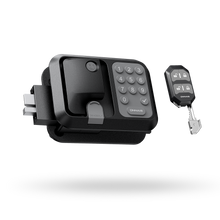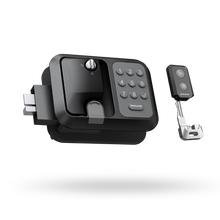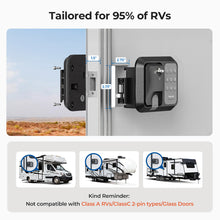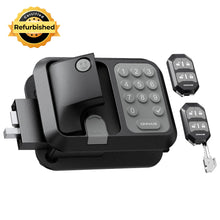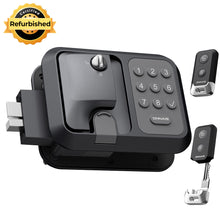How Dust, Sand, and Salt Damage RV Locks (and How to Prevent It)

When we think about RV maintenance, we often focus on big-ticket items—engine checks, roof seals, or tire care. But one small and often-overlooked component can make or break your travel plans: your RV locks.
Whether it’s your entry door, storage compartments, or hitch lock, these small mechanisms face constant exposure to the elements. Over time, dust, sand, and salt can sneak their way inside, causing internal wear, corrosion, and eventually failure.
Understanding how these contaminants damage your locks—and knowing how to prevent it—can save you from costly replacements and frustrating breakdowns on the road. In this post, we’ll explore the science behind these issues and share expert strategies for RV lock corrosion prevention and preventing RV lock rust.
The Anatomy of an RV Lock
Before diving into how the damage happens, let’s understand what an RV lock is made of.
Most RV locks—especially entry and compartment types—are built with metal components such as stainless steel, zinc alloy, or brass. These materials are chosen for strength and resistance to weather. Inside, there are small springs, tumblers, and pins that must move freely for the lock to function properly.
When contaminants like dust, sand, or salt enter the mechanism, they interfere with these moving parts. What starts as slight stiffness in the key turn can quickly escalate into corrosion, seizing, and total lock failure.
How Dust Damages RV Locks
Dust may seem harmless, but from a mechanical perspective, they are nature's sandpaper. For RV locks, it’s the silent killer.
Mechanism of Damage:
Dust particles accumulate inside the keyway and on lubricated surfaces.
Over time, this buildup forms a fine abrasive paste—essentially “grinding” away at internal metal surfaces.
The result? Increased friction, difficulty inserting keys, and premature wear on springs and pins.
In dusty environments—like desert highways or gravel campsites—this problem is magnified. Fine silica dust can even infiltrate sealed locks through small gaps or ventilation holes.
Prevention Tips:
Use lock covers or caps on exterior keyholes when parked in dusty regions.
Avoid over-lubrication—too much oil attracts and traps dust.
Opt for dry graphite or PTFE-based lubricants, which repel debris and keep the mechanism moving smoothly.
Wipe locks clean with a microfiber cloth after dusty drives.
The Gritty Truth About Sand
Sand damage is similar to dust—but with an extra punch. Unlike fine dust, sand particles are coarse, heavy, and jagged.
Mechanism of Damage:
When sand enters a lock, it physically wedges between moving parts.
As you insert or twist the key, these grains scrape metal surfaces, enlarging gaps and deforming pins.
Over time, this leads to key misalignment and lock jams.
Beyond abrasion, sand acts as a sponge for moisture. A buildup of dust inside the lock housing can absorb humidity from the air, creating a damp environment that is the perfect precursor to rust.
RV owners who frequent beachfront campgrounds or coastal dunes face this problem often. Even a short stroll from the ocean to your RV can carry sand on shoes, gear, and hands straight into the locks.
Prevention Tips:
Keep handheld air blowers or a can of compressed air to regularly clear out grit.
After beach trips, rinse locks gently with clean water, then dry thoroughly.
Install rubber gaskets or dust shields around compartment locks to block sand intrusion.
Store spare keys in sealed plastic bags when near sandy environments.

Salt—The Corrosion Catalyst
Among all environmental threats, salt is the most destructive. Whether it’s coastal air, winter road salt, or marine spray, salt exposure rapidly corrodes metal locks.
Mechanism of Damage:
Salt attracts and retains moisture, keeping locks damp for long periods.
This constant humidity accelerates oxidation, leading to rust and pitting on metal surfaces.
In combination with oxygen, sodium chloride creates an electrolytic reaction that eats away at protective coatings.
Once corrosion begins, the damage spreads internally—making the lock stiff, discolored, and eventually unusable.
For RVers traveling along coasts or through snowy regions, this is the number-one cause of lock corrosion and failure.
Prevention Tips (for RV lock corrosion prevention):
Rinse locks with freshwater after driving on salted roads or staying near the ocean.
Apply corrosion inhibitor spray (marine-grade silicone or Teflon-based).
Use stainless steel or corrosion-resistant lock models if you travel frequently in salty environments.
Perform seasonal maintenance—clean and lubricate all locks at least every three months.

Professional Maintenance Routine for Long-Term Protection
To keep your locks in top condition year-round, adopt this simple yet effective maintenance routine:
1.Monthly Inspection:
Turn and test every lock on your RV.
Watch for resistance, discoloration, or sticky key movement.
2.Cleaning:
Use compressed air to blow out dirt and sand.
For salt exposure, lightly rinse with clean water and dry fully.
3.Lubrication:
Apply a dry lubricant every few months. Avoid WD-40—it can leave residue that attracts dust.
For exterior locks, use a weatherproof silicone spray for extra protection.
Protect Small Parts, Prevent Big Problems
Dust, sand, and salt might seem like minor nuisances, but they’re the silent saboteurs of your RV’s security. Once corrosion sets in, even the best key won’t turn smoothly—and a stuck lock can derail your adventure fast.
By understanding how these elements attack your locks and applying a consistent maintenance routine, you’ll safeguard both your locks and your peace of mind.

